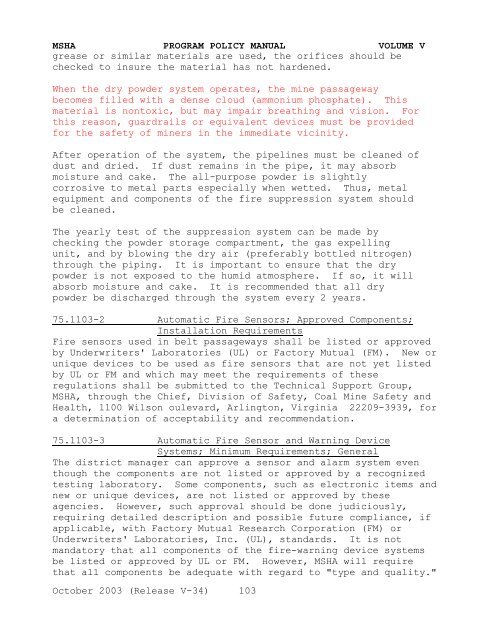Program Policy Manual - VOLUME V - Mine Safety and Health ...
Program Policy Manual - VOLUME V - Mine Safety and Health ...
Program Policy Manual - VOLUME V - Mine Safety and Health ...
Create successful ePaper yourself
Turn your PDF publications into a flip-book with our unique Google optimized e-Paper software.
MSHA PROGRAM POLICY MANUAL <strong>VOLUME</strong> V<br />
grease or similar materials are used, the orifices should be<br />
checked to insure the material has not hardened.<br />
When the dry powder system operates, the mine passageway<br />
becomes filled with a dense cloud (ammonium phosphate). This<br />
material is nontoxic, but may impair breathing <strong>and</strong> vision. For<br />
this reason, guardrails or equivalent devices must be provided<br />
for the safety of miners in the immediate vicinity.<br />
After operation of the system, the pipelines must be cleaned of<br />
dust <strong>and</strong> dried. If dust remains in the pipe, it may absorb<br />
moisture <strong>and</strong> cake. The all-purpose powder is slightly<br />
corrosive to metal parts especially when wetted. Thus, metal<br />
equipment <strong>and</strong> components of the fire suppression system should<br />
be cleaned.<br />
The yearly test of the suppression system can be made by<br />
checking the powder storage compartment, the gas expelling<br />
unit, <strong>and</strong> by blowing the dry air (preferably bottled nitrogen)<br />
through the piping. It is important to ensure that the dry<br />
powder is not exposed to the humid atmosphere. If so, it will<br />
absorb moisture <strong>and</strong> cake. It is recommended that all dry<br />
powder be discharged through the system every 2 years.<br />
75.1103-2 Automatic Fire Sensors; Approved Components;<br />
Installation Requirements<br />
Fire sensors used in belt passageways shall be listed or approved<br />
by Underwriters' Laboratories (UL) or Factory Mutual (FM). New or<br />
unique devices to be used as fire sensors that are not yet listed<br />
by UL or FM <strong>and</strong> which may meet the requirements of these<br />
regulations shall be submitted to the Technical Support Group,<br />
MSHA, through the Chief, Division of <strong>Safety</strong>, Coal <strong>Mine</strong> <strong>Safety</strong> <strong>and</strong><br />
<strong>Health</strong>, 1100 Wilson oulevard, Arlington, Virginia 22209-3939, for<br />
a determination of acceptability <strong>and</strong> recommendation.<br />
75.1103-3 Automatic Fire Sensor <strong>and</strong> Warning Device<br />
Systems; Minimum Requirements; General<br />
The district manager can approve a sensor <strong>and</strong> alarm system even<br />
though the components are not listed or approved by a recognized<br />
testing laboratory. Some components, such as electronic items <strong>and</strong><br />
new or unique devices, are not listed or approved by these<br />
agencies. However, such approval should be done judiciously,<br />
requiring detailed description <strong>and</strong> possible future compliance, if<br />
applicable, with Factory Mutual Research Corporation (FM) or<br />
Underwriters' Laboratories, Inc. (UL), st<strong>and</strong>ards. It is not<br />
m<strong>and</strong>atory that all components of the fire-warning device systems<br />
be listed or approved by UL or FM. However, MSHA will require<br />
that all components be adequate with regard to "type <strong>and</strong> quality."<br />
October 2003 (Release V-34) 103
















